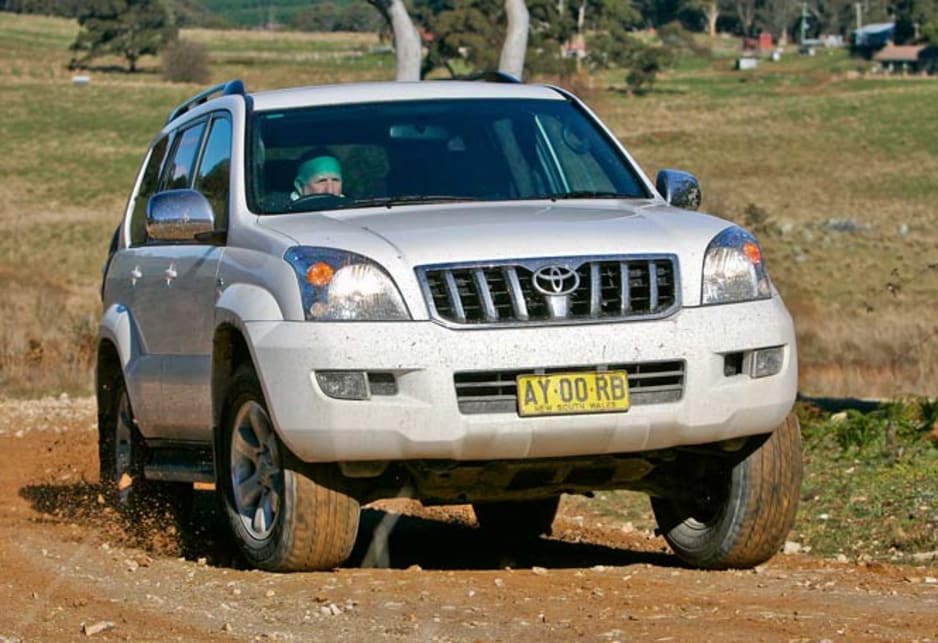
Prado vs Hilux 2009 Review
- Toyota HiLux
- Toyota Land Cruiser Prado
- Toyota HiLux 2009
- Toyota Land Cruiser Prado 2009
- Toyota HiLux Reviews
- Toyota Land Cruiser Prado Reviews
- Toyota Reviews
- Toyota Commercial Range
- Toyota SUV Range
- Toyota Ute Range
- Commercial
- SUV
- Ute
- Toyota
- Family Cars
- Tradies
- 7 seater

People regularly ask us the question, should I buy a Prado or a dual-cab HiLux? … almost as often as the question what's the best, Prado or Pajero.
Prado and HiLux are the biggest selling vehicles in their respective classes so it's not surprising that the wagon versus dual-cab ute question most often revolves around these two. For the purpose of this comparison exercise we have chosen the popular turbo-diesel models (in automatic guise) rather than the V6 petrols.
SPEC TESTED
The Prado is a mid-spec GXL model while the HiLux is a top spec SR5, the nearest equivalent to the Prado GXL in terms of equipment given that Toyota doesn't offer (not yet, anyway!) luxuries like leather, sat-nav or safety kit like electronic stability and traction control in a 'Lux.
PRICING
At these spec levels the Prado asks $61,040 (plus on-road costs) while the HiLux is $53,980. Add $2500 for a genuine Toyota or aftermarket canopy to bring the ute up to the storage functionality of the wagon and you are looking at a difference of less than $5000.
One may be a ute and the other a wagon, but Prado and HiLux share much in common as far as suspension, safety and engines go. But there are differences, and important ones at that.
SUSPENSION
The HiLux's rear axle is sprung and located by traditional leaf springs while the Prado's rear axle is sprung via coils and located by four trailing arms and a Panhard rod.
4WD SYSTEMS
Just as significant is the fact that the HiLux uses old-school part-time 4WD while the Prado has full-time 4WD via a torque-sensing centre differential.
ENGINES
The HiLux's engine is also in a lower state of tune than that of the Prado. While both make similar maximum power (126kW for the HiLux and 127kW for the Prado), the Prado has a higher maximum torque output (410Nm versus 343Nm). This extra torque translates to more power right through the rev range with the HiLux only coming close to matching the Prado in the higher reaches. The Prado also has the added advantage of a five-speed automatic while the HiLux has to make do with the four-speed auto that was used in the Prado before the five-speeder was introduced.
With considerably more power just about everywhere and the benefit of its five-speed auto the Prado has the wood on the HiLux for performance. But the difference is not as much as you might think, as the HiLux is some 300kg lighter than the Prado.
What's more noticeable than the actual performance difference is the fact that the Prado feels more relaxed and effortless than the HiLux, which seems to work harder to achieve less. Much of this comes down to the two gearboxes. The Prado's five-speeder is 'smarter' and more decisive than the HiLux's four-speeder and it shifts more quickly and more smoothly. For its part, the HiLux's box shuffles between the gears more and slurs the changes and doesn't feel as effective in getting the most out of the engine.
FUEL ECONOMY
Interestingly both HiLux and Prado have an ADR fuel figure of 9.3 litres/100km, which suggests the Prado's more powerful and sophisticated powertrain makes up for the HiLux's weight advantage. Our test figures from a driving mix that included a fair proportion of off-road work saw the HiLux consume 11.9 litres/100km while the Prado was slightly thirstier at 12.8 litres/100km.
OFFROAD ABILITY
The Prado continues to win the battle off road. While a standard GXL Prado doesn't have the advantage of the traction control that's standard on top-spec models and optional other automatic Prados (including the GXL), it does have a couple of advantages over the HiLux. Most importantly its rear axle has more travel than the HiLux but it also benefits from lower gearing.
But more significant than these advantages is the fact that the Prado is far more comfortable off-road than the HiLux, at least when the HiLux is lightly loaded. With the extra weight of a canopy and/or gear in the tray the HiLux's ride would be more forgiving but, unladen, or even lightly loaded, the ride is hard. That's just a fact of life with a ute.
WAGON VS UTE
Aside from the fact that the Prado seats eight while the HiLux seats five, the wagon does have other advantages over the ute. The Prado's front seats are far more comfortable and the rear seat more accommodating than the HiLux's in terms of leg, shoulder and hip room. The Prado also has lap-sash seat belts for all eight passengers while the HiLux's rear centre seat is fitted with a lap-only belt.
Read more great 4WD and off-roading news in the latest edition of Overlander magazine or visit www.overlander.com.au
Pricing guides
Range and Specs
| Vehicle | Specs | Price* | |
|---|---|---|---|
| Standard (4X4) | 3.0L, Diesel, 6 SP MAN | $16,940 – 21,780 | 2009 Toyota Land Cruiser Prado 2009 Standard (4X4) Pricing and Specs |
| GXL (4X4) | 3.0L, Diesel, 5 SP AUTO | $22,770 – 28,050 | 2009 Toyota Land Cruiser Prado 2009 GXL (4X4) Pricing and Specs |
| GX (4X4) | 3.0L, Diesel, 5 SP AUTO | $19,360 – 24,530 | 2009 Toyota Land Cruiser Prado 2009 GX (4X4) Pricing and Specs |
| VX (4X4) | 3.0L, Diesel, 5 SP AUTO | $24,200 – 29,810 | 2009 Toyota Land Cruiser Prado 2009 VX (4X4) Pricing and Specs |
$8,000
Lowest price, based on 91 car listings in the last 6 months






